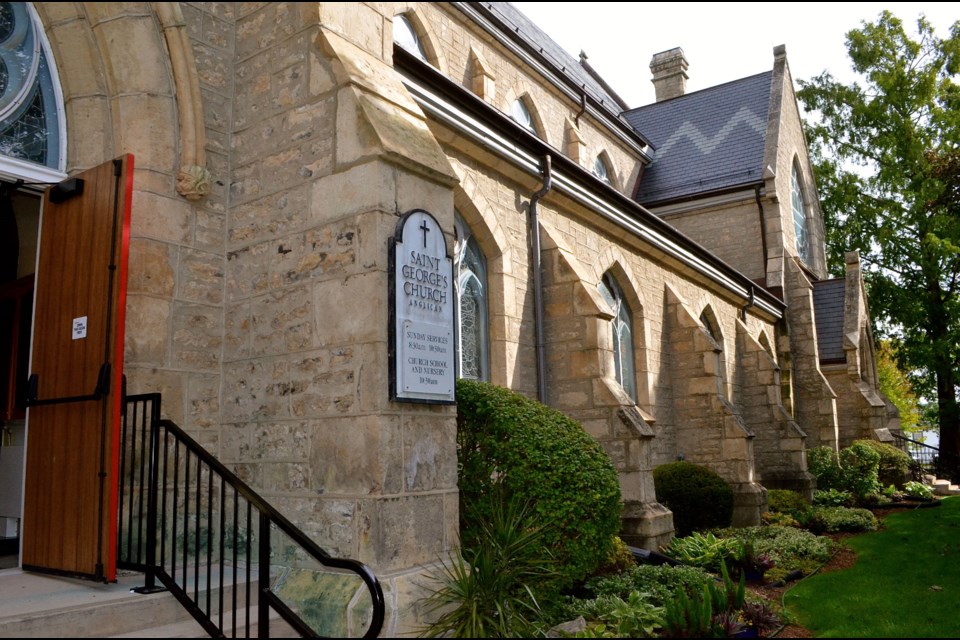The climb to the carillon organ in the bell tower at St. George’s Anglican Church is a steep 56 steps, so you need to be in reasonably good shape just to get to it – playing it is a whole other challenge.
“When I played in Lubeck, Germany, in 2017 I had to climb 250 steps,“ said carillonneur Gerald Martindale. “I tour every summer in the United States and I tour every three years in Europe as well so, I have played many carillons in churches, city halls and separate towers.”
Martindale is from a fairly exclusive group given that the Guild of Carillonneurs in North America has just over 400 members. It was a rare treat for people within earshot of St. George’s to hear him play a half-hour recital after services Sunday morning.
“It’s not very often that we have a carillonneur play for a program like this today,” said Gerald Manning, music director at St. George’s. “Gerald Martindale has been playing here on his own from time to time because he likes the instrument. He plays a number of recitals in the US during the summer and we thought let’s get him to come here in September and play one for us.”
The carillon at St. George’s is one of only 12 in Canada. It was gifted to the church by the Cutten estate in 1926 and the original 23-bell system gave the instrument a two-octave range.
“A carillon by definition has to have at least 23 bells so some churches might have three or four bells or eight bells but a carillon, which is played from a keyboard with wooden levers that you hit with your fist has to be at least 23 bells,” said Manning. “The one in the Peace Tower in Ottawa would be the most famous one for people in Canada.”
In 2006 the bell tower at St. George’s was renovated and an additional 13 bells were added to give the carillon a three-octave range
“This one now has 36 bells and it makes a lovely sound because the bells were all retuned at that time and it has a new playing keyboard,” said Manning. “We are really happy to have it used.”
Each cast-bronze bell is tuned to a specific note in the musical scale and the tone is determined, for the most part, by the size and shape. The largest bell in St. George’s carillon is the tolling bell weighing 4,000 lbs.
The bells are also connected to the large clock on the tower that has been striking every quarter hour and playing Westminster Chimes at the top of every hour since 1926. The mechanism for the clock and bell system is located half way up the bell tower on a landing below the carillon organ.
Playing the carillon is physically challenging and takes many years to master but you don’t have to be a member of the carillonneur guild to play the instrument. There are a number of local musicians that play the carillon at St. George’s for weddings, funerals, Christmas celebrations and regular services. Visitors to the church are welcome to make the climb up the bell tower to get a first-hand look at the impressive system of batons, cables, pedals and bells.
Martindale has been climbing carillon towers around the world for more than 25 years.
“I studied piano and organ for years and one day someone demonstrated carillon and I was totally fascinated so I began to take lessons from the former university of Toronto carillonneur,” he said.
He was appointed carillonneur for the Metropolitan United Church of Toronto in 1997 and retired in the spring of 2016. He plays regularly at Exhibition Place and has toured extensively throughout Europe and the US where he has played carillons in some of the most famous churches and towers in the world.
He lives in Toronto and makes the trip to Guelph whenever he can.
“I play the Exhibition Place carillon regularly,” he said. “I play here about once a month.”
When asked to rate the carillon at St. George’s in relation to the historic and iconic instruments he has played around the world during his career, he responded with on word.
“Excellent!”







